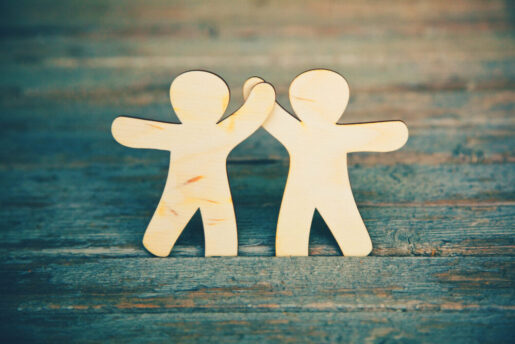Paul Eastwick, professor of psychology at UC Davis, speaks to David B. Wilkins, faculty director of the Center on the Legal Profession, about what law firm partners can learn from social psychology.
David Wilkins: Thank you for talking to me, Professor Eastwick. You are a social psychologist, which may seem at first odd to our readers. But I think there are important links between your work and mine on the legal profession. As you know, this issue of The Practice focuses on how we think about the perfect law firm partner, both internally within firms as well as vis-à-vis clients. Key to all of this is the idea of “relationships” and “partnerships.” And it occurred to us that there’s a whole set of people who think about relationships in a serious, rigorous way. So I’d just like to start by asking you, what is relationship science?
Paul Eastwick: The field of relationship science is typically interested in understanding how relationships work. How do people think about their romantic partners? Many of us, although not all of us, are psychologists. Ultimately, we’re interested in what is going on internally within people’s minds as they form partnerships, and what are the behaviors that people engage in that produce those thoughts and feelings that end up being central to a relationship.
We document the various predictors of what makes relationships satisfying or unsatisfying. We document the behaviors that make relationships more or less stable. We ask: What are the motivated reasoning processes that people engage in to defend that relationship against threats?
Finally, we ask: What does a relationship offer individuals? Being in a close relationship often has a lot of benefits—health benefits, physiological benefits, and so on. We’re interested in those questions too.
Wilkins: In studying these questions, what are your main research methods?

Eastwick: We use a lot of self-reporting or survey-based methods. When you want to get at people’s subjective sense—their internal beliefs, ideas, and feelings about a partner—the best way to do that typically is to ask people.
We do a lot of observational work, too. It’s very common in the study of romantic couples, for example, to bring couples together into the lab and see how they interact with each other when they’re discussing an important problem. For people who are interested in studying attraction, and how relationships form in the first place, you might look at how they behave on some online apps or you might introduce people to each other for the first time in a laboratory-type setting, and see who tends to like whom.
Wilkins: The spin we are most interested in, as I said, is in the professional context, but it could be the business world more generally. As you know, people in these spaces often use words that you are studying in the romantic context—words like partnership, trust, collaboration, goals, and values. They often view these concepts as critical to meaningful relationships. I wonder, as you think about those concepts, are we talking about the same thing?
The problem is that it’s very hard to figure out—in any prospective way—which pairs of people are going to be compatible and which pairs of people are not.
Paul Eastwick, UC Davis
Eastwick: I think there are certainly going to be some important parallels between business settings and relationships when talking about shared values and goals. When you ask people “What are some of the things that make your relationship work well?” you’ll hear about shared values and goals, for sure. Surely, people have similar ideas about what makes for a good law partnership. Now, what actually makes a romantic relationship, or presumably any legal partnership work well, is a different question. It may be the same, or it could end up being different.
Wilkins: You have a theory you’ve been developing called mate evaluation theory, which is about how couples fit. I’m curious, what lessons are you gleaning from that, particularly about this potential disconnect between what people say they want in an ideal partner and how that real partner meets those expectations?
Eastwick: The theory basically boils down to this: compatibility is a thing that people generally believe to be very important when it comes to any kind of romantic connection, whether that’s initial attraction or an ongoing relationship. Some pairs will make each other very happy. Other pairs will make each other miserable. The problem is that it’s very hard to figure out—in any prospective way—which pairs of people are going to be compatible and which pairs of people are not. For example, what people say they want in a romantic partnership corresponds pretty weakly with what ends up appealing to them once they actually meet someone.
The way that we try to square this circle, or resolve this puzzle, is by pointing out that a lot of what makes relationships compatible or incompatible is constructed along the way and not meaningfully predictable from things you could have learned about two people before they met each other in the first place. It’s not really about matching in the classic sense of “These puzzle pieces go together” or “These two sets of gears fit together nicely.” Instead, you can think of two kids playing in a sandbox. Are they constructing something by playing off of each other, listening to each other, and creating some edifice that makes sense? Or are they just not able to work that well together, maybe because they got off on the wrong foot at the start or because somewhere along the way one person got one idea and somebody else had a different idea? It helps to think about compatibility as something that is grown, or fails to grow, as a relationship forms and takes shape.
People aren’t really meant to be able to maintain hundreds of close relationships all at the same time.
Paul Eastwick
Wilkins: That’s really interesting, and very useful for the context we’re talking about, but also complicated. It used to be that law firm partnerships were quite small. The people were quite homogeneous. They oftentimes came from the same social background, racial background, religious background, maybe even school background. Now, we have these partnerships that are made up of hundreds of people spread across very large geographies. How do you think about relationships across differences?
Eastwick: When it comes to the differences that you might document about two people on paper—even if it’s things like family background, demographic differences—there’s really not much evidence that matching or mismatching on these variables accounts for much of anything. Nevertheless, people aren’t really meant to be able to maintain hundreds of close relationships all at the same time. Our brains can’t handle that. We typically have a small handful of close confidants with whom we’re willing to be especially vulnerable, and a slightly wider circle of close friends whom we’ll put our trust in, but the further out you get, it’s not going to be an “I’m willing to do anything for you” relationship. That’s the nature of the human experience.
When you’re talking about a “partnership” that has hundreds and hundreds of people, that’s stretching what the human mind can handle in terms of the parallel with a “real” partnership. What is it like to know somebody else? What is it like to really be considerate of their needs? To consider their needs equal to your own? That’s what a close romantic relationship usually entails—a blending of two people’s needs and desires, and the eagerness to sublimate your own needs for the sake of somebody else. That is very common in close relationships. But we can only expect people to do that for a tiny handful of people in their lives at any one time.
Wilkins: What about the issue of difference? You say different demographic or socioeconomic backgrounds don’t provide a lot of predictive evidence about someone’s relationship. We also know that once people are in relationships, conflicts arise based on these differences, or worldviews. What does relationship science tell us about handling conflict resolution?
Eastwick: It’s tricky. When things go sideways, people then look for the differences that are causing these conflicts. But that same difference, when placed on another relationship, is totally fine. This is the challenge. You can’t just look for: “Political differences, Danger! Stay away!” That ultimately isn’t a helpful diagnostic tool, because when people want it to be good, they’ll find the reasons for it to be good. When people want it to be bad, they’ll find the reasons. This is part of the motivated reasoning that people engage in.
There is a separate question: Are some people good at handling conflict, whether in a relationship or an organization? That is, perhaps some people are good at handling conflict. They’re the kind of relationship partner you want to be with. This is where relationship science has some interesting things to say. For most professional skills, we would say, “Of course there are people who are better or worse at the thing,” and people develop those skills over time. The funny thing is, when it comes to relationship skills, the evidence is not that great that some people are good at making their partner happy and other people are bad at managing conflict. It’s not that there’s nothing to it, but it’s a very insignificant portion of explaining why some relationships are good and some relationships are bad.
Face-to-face interaction is the way that people feel that they have a real relationship with another person, and that they’re motivated to be on their best behavior to maintain it, to make interactions go smoothly, and to not be a jerk.
Paul Eastwick
This is an example that people find intuitive: Think about families for a second. Imagine a family where there are two parents and several kids. Just ask everybody in the family to rate everybody else in terms of how supportive they are. Is Mom supportive? Is Dad supportive? Is Brother supportive, Sister supportive, etc.? If you ask each person, you will get almost no agreement about who is supportive and who is not. This is a well-established finding in the family literature. It’s all dyadic. It’s all relational. Brother and Sister find each other supportive. One thinks Dad is supportive; one thinks Mom is supportive. Mom thinks Kid One but not Kid Two is supportive. It’s a dyadic phenomenon with very little agreement about who is good at this and who is not.
My suspicion would be that in many workplace contexts that are about dealing with people and emotionally meaningful material, this is what happens. In medical settings, for instance, how you feel about your doctor—if you think your doctor cares for you—this is going to end up being a pretty critical component of whether you want to sue the doctor or not. To the extent that the family literature has any parallel, it suggests that a lot of what’s going on there is dyadic. And it’s very challenging to identify the people who are good at it and the people who are not.
Wilkins: Very helpful, and maybe that suggests that even in a big partnership, the relationships that matter are the dyadic ones, and not something to some abstract entity called the partnership of the firm—or even to the 400 individual partners.
What about geographic distance? You’ve got people who are trying to maintain relationships across space and time zones. Is there anything that relationship science can help us with how to think about ways to do that effectively?
Eastwick: This gets into some of the work in the attraction realm, showing that there’s a pretty big difference between what it’s like to interact with somebody: Are they just a name on a piece of paper, are you interacting with them with just written communication, or have you met them face-to-face? Zoom has started to bridge that difference, and a lot of this research predates how common video interactions have been. That caveat notwithstanding, face-to-face interaction is the way that people feel that they have a real relationship with another person, and that they’re motivated to be on their best behavior to maintain it, to make interactions go smoothly, and to not be a jerk. When you make those things purely virtual—and when they’re happening at a distance—people are often not as inclined to give the other person the benefit of the doubt, to issue lots of goodwill, to really consider the other person’s needs and wants. They become this abstract entity that is much easier to blow off.
People evolved in a context where you only knew a few other people, and those groups tended to work well when people had each other’s backs and when they looked out for each other’s needs.
Paul Eastwick
This is a problem for any organization or any group of people that is going to be working at a distance. If there is no opportunity for meaningful face-to-face interaction, it’s very easy to start treating those people like an “other.” They’re not within your tight sphere. They’re out there within that more abstract, distant set of people that you don’t have to be on your best behavior for. This is a real challenge. How do you get people to feel close and cooperative, when there are just so many distances?
Wilkins: It’s also a really interesting and perhaps powerful way to entice people to spend more time face-to-face.
One last question. Given everything you know, and everything you’ve been studying, any advice you would give to a lawyer or other professional who wants to try to build meaningful relationships in this context? Things that they should be thinking about or looking out for in a way that might help them in doing this process?
Eastwick: People evolved in a context where you only knew a few other people, and those groups tended to work well when people had each other’s backs and when they looked out for each other’s needs. That’s not to say that they neglected their own needs, but the closest relationships tended to be ones where you would engage in sacrifices for another person without the immediate expectation that you were going to be paid back in any tangible way. Now, when you’re talking about work for hire, there is an expectation that I am giving you money, and I’m getting a service back.
But it is worth keeping in mind that there is still a psychological component. When people say, “I want to have a relationship with you,” what that means is, “Yes, I understand this is transactional, but I really want to feel like my needs are central to your thinking.” This is what I imagine a client would be feeling. “Yes, this is a transactional relationship, but to the extent that I have this sense that my needs are top of mind for you, that you’re willing to make sacrifices for me, that’s going to make that relationship feel a lot more like the close relationships that we’re used to in the rest of our lives.”
Wilkins: In a way, we end where we began, but much more thoughtfully. These are not the same as intimate partner relationships, and yet, there’s an aspect of them that good professional relationships have to have if they are to be meaningful for people. Thank you for taking the time.
Paul Eastwick joined the UC Davis psychology department faculty in 2016, where he serves as the principal investigator for the attraction and relationships research laboratory. Through his research, he has sought to build connections between attraction/close relationships research, evolutionary psychology, social psychological perspectives on person perception and implicit social cognition.
David B. WIlkins is the faculty director of the Center on the Legal Profession and the Lester Kissel Professor of Law, Vice Dean for Global Initiatives on the Legal Profession at Harvard Law School.



